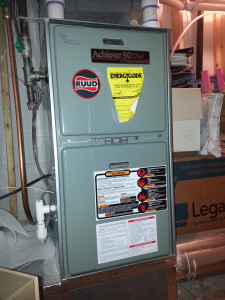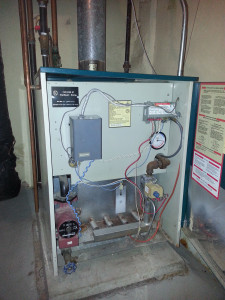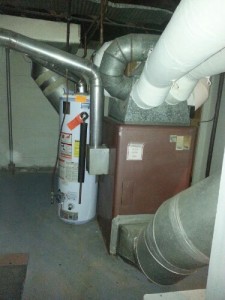There are many types of furnaces that you will find in these Minneapolis homes. In this brief article, I am going to cover the most common types you’ll see and discuss the positives and negatives of each. Let’s get started.
 The most common type of furnace is the forced air furnace. This type of furnace draws air from the house, then heats (or cools) the air, and distributes it to the various rooms via ducts. The ducts are in the floors, ceilings, and walls. The main benefit of these systems is that they are usually quite effecient and heat up the air (or cool the air) pretty quickly.
The most common type of furnace is the forced air furnace. This type of furnace draws air from the house, then heats (or cools) the air, and distributes it to the various rooms via ducts. The ducts are in the floors, ceilings, and walls. The main benefit of these systems is that they are usually quite effecient and heat up the air (or cool the air) pretty quickly.
The downside of these systems is that in the heat mode (winter), the forced air furnace drys out the air. Many people put a humidifier system on the furnace to moisten the air, but these systems usually leak or drip, or have valves that don’t close fully, or any numerous other problems. They also require frequent cleaning of the screen. After experiencing these systems for decades, I’ve not come across one humidifier system that is reliable.
These forced air furnaces are relatively efficient. They range from about 60% (for old furnaces) to 90 to 95% efficient. The one in the photo is a 90%+ efficient furnace.
Forced air furnaces usually last anywhere from 12 years for an inexpensive model, to 20+ years for a high quality model. A typical replacement system to the one pictured would be around $2500 for the furnace, and $1500 for the air conditioning system, for a typical house of about 2000 sqft.
 The next most common system is the boiler. There are two types of boilers, ones that create steam and circulate steam through the radiators, and one that heats and circulates water through the radiators. They are known respectively as “steam heat” or “hot water heat” systems. This photo is of a boiler that circulates hot water. The primary benefit of these systems is that they radiate the heat to the objects in the room, rather than heating the air in the room. This means that you can have the heat set a couple of degrees cooler than a forced air furnace and feel just as comfortable. They also don’t dry out the air like a forced air furnace.
The next most common system is the boiler. There are two types of boilers, ones that create steam and circulate steam through the radiators, and one that heats and circulates water through the radiators. They are known respectively as “steam heat” or “hot water heat” systems. This photo is of a boiler that circulates hot water. The primary benefit of these systems is that they radiate the heat to the objects in the room, rather than heating the air in the room. This means that you can have the heat set a couple of degrees cooler than a forced air furnace and feel just as comfortable. They also don’t dry out the air like a forced air furnace.
The main downside of these systems is that they take a long time to heat up. If they don’t have a circulation pump and rely on gravity, they can take 2 hours or more to heat up. With a circulation pump, they can take 1-2 hours.
One drawback for boilers is that you can’t have air conditioning with this system. Most people that want a/c with boilers put in a separate system just for air conditioning. There are 3 types of common systems for homes that have boilers. The first is called SDHV, or small duct high velocity. These are, as the name implies, small ducts with little openings in the ceilings or walls that put out a high velocity of cold air. The openings are usually around 2″ in size.
The second common type is to put in regular ducts and regular registers. This can be intrusive if you are adding it to an already finished house. But if you have unfinished attic space, this may be a good option. Or if you have a single level home, and an unfinished basement.
The third common type is to put in what’s called a “ductless split” system. In this case, you’ll have an outdoor compressor unit that will feed one or more inside condenser units. Each room can have its own condenser unit and be controlled individually.
Boilers can range from 60% efficient (older) to 80 or 90% efficient on a modern one. This boiler is about 20 years old, and if it is still up to the original specs, is 80% efficient. I wouldn’t count on it being 80% because it is a bit older, maybe 75% efficient.
Most boilers can last 30-40+ years, but they are more expensive than force air systems. A typical boiler such as the one in the photo would be around $6,000 to replace.
 The last common system is the gravity furnace. The one in this photo is slightly newer than the bulkier older ones. Those are affectionally known as “octopus” furnaces due to their massive size and large ducts. They can make the entire basement unusable! They rely on the principle that warm air rises and cool air sinks, hence the name gravity heat. The main benefits of this type of heating is that the air doesn’t move around much, and they have so few parts to break. There really is only a burner and a temperature control of some sort. Otherwise it is just a large metal box. The main disadvantage is that it takes up so much space, and that replacing this furnace with a modern furnace is expensive. That is because most of the pipes are wrapped in asbestos, as well as the furnace itself. So you’ll need guys in suits to abate the old ductwork. In this photo, the upper white colored pipes are probably wrapped in asbestos, while the silver ones and the furnace itself are not.
The last common system is the gravity furnace. The one in this photo is slightly newer than the bulkier older ones. Those are affectionally known as “octopus” furnaces due to their massive size and large ducts. They can make the entire basement unusable! They rely on the principle that warm air rises and cool air sinks, hence the name gravity heat. The main benefits of this type of heating is that the air doesn’t move around much, and they have so few parts to break. There really is only a burner and a temperature control of some sort. Otherwise it is just a large metal box. The main disadvantage is that it takes up so much space, and that replacing this furnace with a modern furnace is expensive. That is because most of the pipes are wrapped in asbestos, as well as the furnace itself. So you’ll need guys in suits to abate the old ductwork. In this photo, the upper white colored pipes are probably wrapped in asbestos, while the silver ones and the furnace itself are not.
Gravity furnaces are not known for their efficiency, just because they are from such a long time ago. Most estimates put these gravity furnaces around 60-65% efficient.
The cost to replace these with a modern forced air furnace and air conditioner would be around $9000 due to the asbestos.
To add air conditioning to these systems, it is usually best to replace the furnace with a modern system. This is because the cost of adding air conditioning to this system would be almost the same cost as replacing the whole system.
